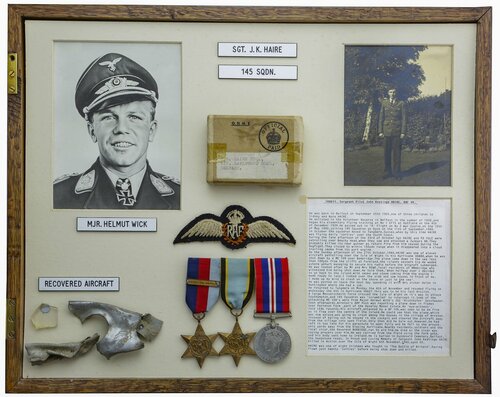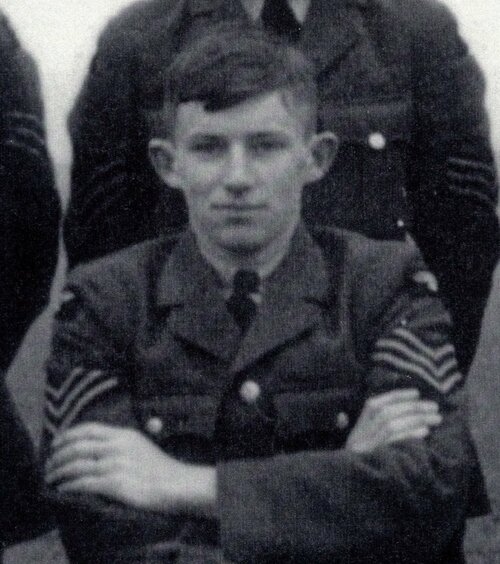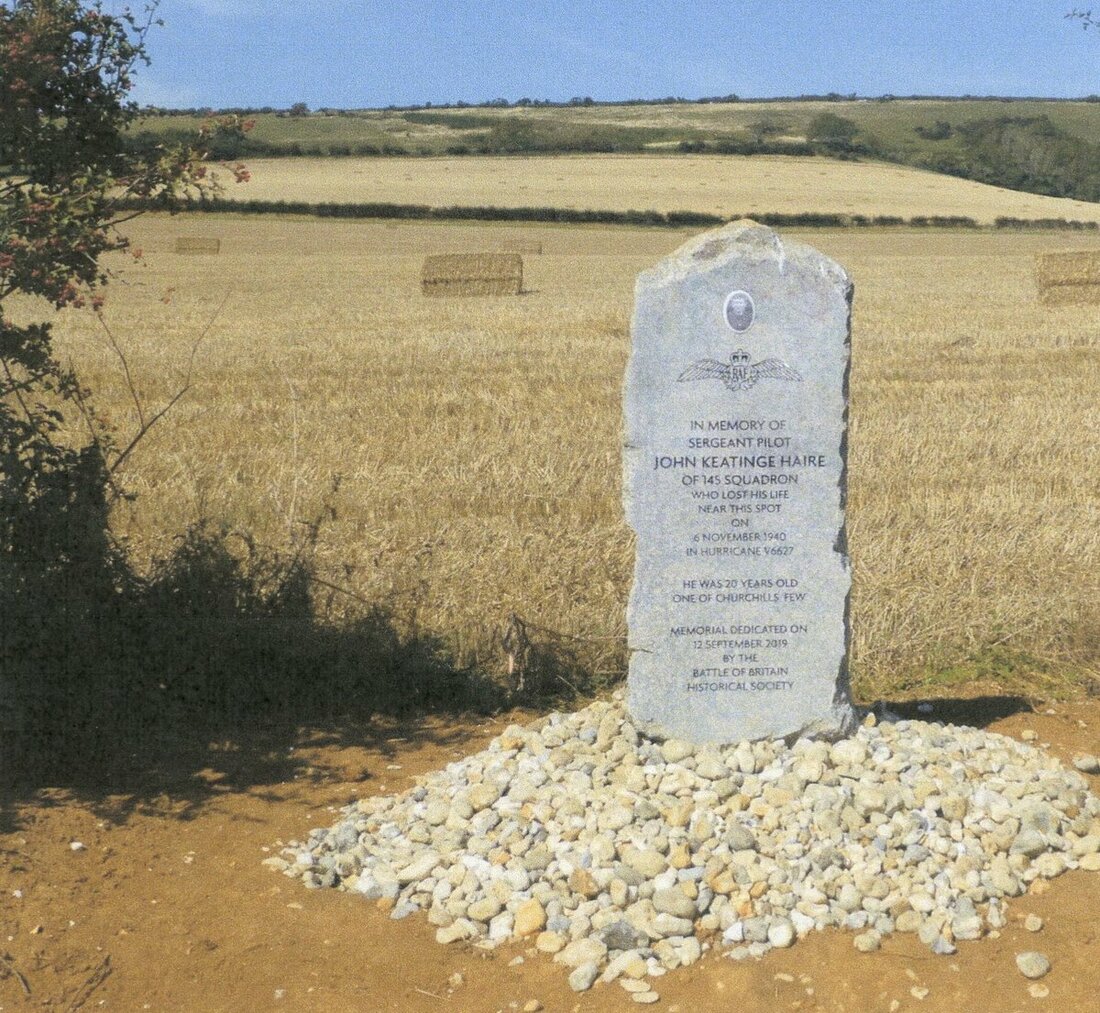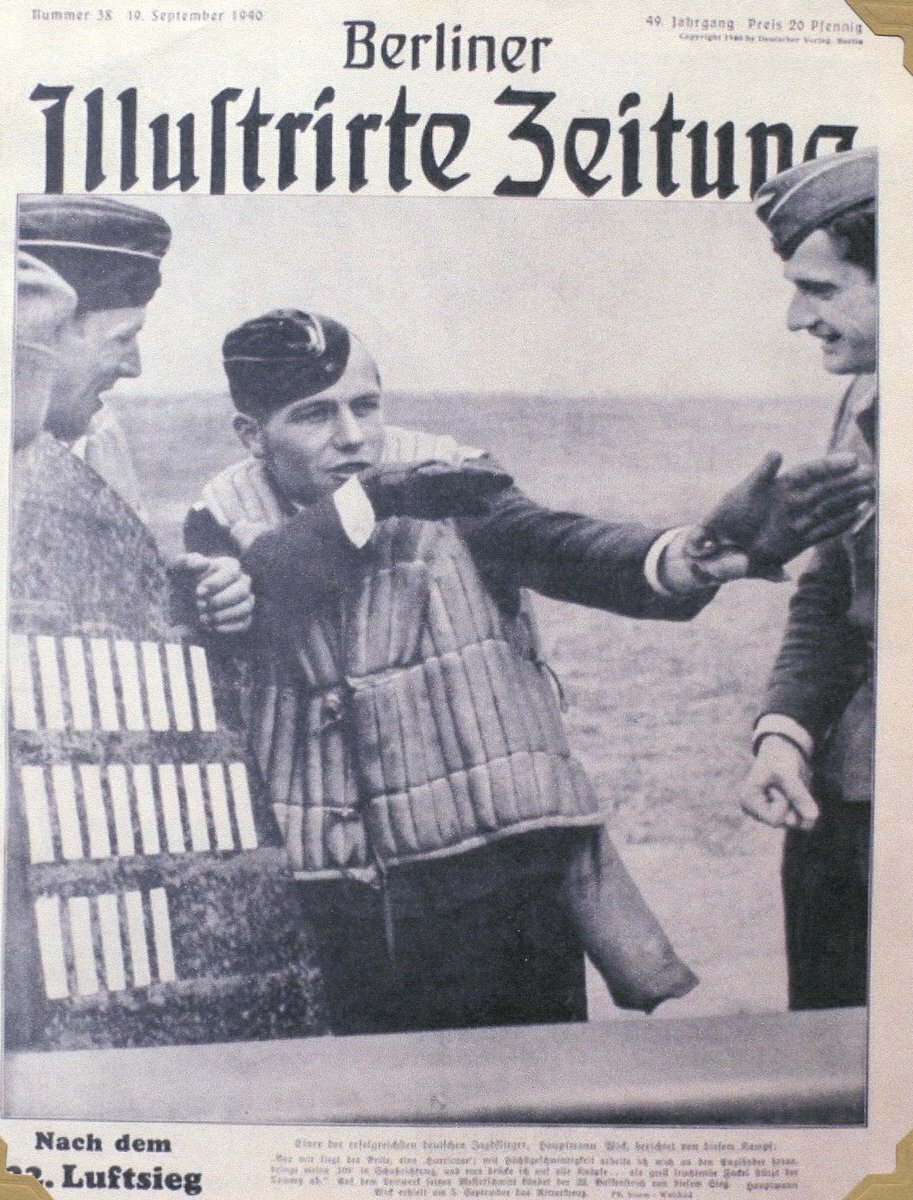Auction: 20003 - Orders, Decorations and Medals
Lot: 455
'The Hurricane was on fire having been attacked by Messerschmitts, and looked like it was going to crash on the houses of Arreton. Instead of baling out the pilot stayed in the aircraft and steered it away into open fields. Only then did he attempt to bale out, standing on the wing before jumping. However, he had left it too late for his parachute to open fully and he fell to the ground.
I rushed to the field with others including the Rev. Edward Burbridge to try to help the pilot. Sadly he died as the vicar was saying prayers over him. We used a farm gate to carry his body out of the field.'
George Calloway, who manned Arreton's A.R.P. post, recalls the fate of Sergeant John Haire, R.A.F.V.R. on Wednesday, 6 November 1940.
A poignant Battle of Britain campaign group of three awarded to Sergeant J. K. 'Bunny' Haire, No. 145 Squadron, Royal Air Force Volunteer Reserve
A gallant 20-year-old Ulsterman, he refused to abandon his crippled Hurricane over the village of Arreton on the Isle of Wight on 6 November 1940, thereby preventing probable loss of local life at the cost of his own; he was likely a victim of the marksmanship of Luftwaffe ace Helmut Wick
Just a week or so earlier, again over the Isle of Wight, he had displayed similar noble intentions, this time avoiding the inhabitants of Firelands, Bembridge by crash-landing his Hurricane on a nearby beach. A coast guard who rescued him from the water's edge later recalled 'he was a fine lad' for 'not at any time did he think of himself'
1939-45 Star, clasp, Battle of Britain; Air Crew Europe Star; War Medal 1939-45, in their original O.H.M.S. card forwarding box addressed to the recipient's father, 'S. H. Haire, Esq., 122, Earlswood Road, Belfast', extremely fine, the whole housed in a glazed display frame, including pieces of aluminium and perspex recovered from the wreck site of his Hurricane - V6627 (Lot)
John Keatinge Haire was born in Belfast on 25 September 1920 and entered the Northern Ireland Civil Service as a clerk after leaving school.
In the summer of 1939, he enlisted in the Royal Air Force Volunteer Reserve and was selected for pilot training, following which, on 11 September 1940, he was posted to No. 145 Squadron, a Hurricane unit operating out of R.A.F. Montrose, Scotland.
At the end of the first week of October, the Squadron was moved south to Tangmere, Sussex, the commencement of a hectic period of operations. On the 23rd, flying as Red 2 to Pilot Officer Robert Yule, Haire fought a combat off Beachy Head:
'At 1710 at 15,000 feet they sighted a Ju. 88 coming out of the cloud and heading in a N.W. direction. Both of them climbed into the sun intending to make a beam attack but the Ju. 88 turned east and dived steeply, with black smoke coming from an engine. Pilot Officer Yule attacked from astern, firing four short bursts of 960 rounds from 350 to 200 yards. Sergeant Haire then attacked and fired two short bursts of 400 rounds at between 250 to 150 yards range. Incendiary bullets were seen to enter the fuselage and return fire came from the upper and rear gun positions, but this ceased during the attack. The Ju. 88 released its bombs and disappeared into thick cloud as white smoke was seen coming from its port engine' (No. 145's O.R.B. refers).
Their victim was likely Ju. 88 A-1 (No. 3151) which crashed near Neuilly Hospital in France.
27 October 1940
During his second patrol on this date, Haire - acting as a 'weaver' - was jumped from behind by Me. 109s over the Isle of Wight and was shot down over Bembridge. Muriel Rowe, who lived at 'Beachclose', Firelands, Bembridge, takes up the story:
'There was an air raid on Portsmouth with the sirens going. I was in the house with my mother, my father was in the bath, and my younger brother David was standing on the coal-bunker watching the planes. Suddenly a plane with smoke pouring out of it appeared over the tree tops, veered off and crashed out of sight on the beach.
My father rushed down the stairs, out and across the fields bare footed, but he was a very good runner. He scrambled down the low cliff and on seeing the pilot struggling to get out of the cockpit waded out to the plane which was in about 6-8 feet of water. Although the tide was coming in, the pilot insisted on returning to get his radio.
After a meal and a change of clothes my father took John Haire to the Coast Guard Station so that his squadron could be contacted and report the state of his aircraft (by this time it was completely submerged). While here John explained that he had hoped to land the plane in the field at Forelands, but realised he didn't have room because of the houses, so made the decision to crash-land on the beach. After spending the night with us he was collected by the police the next day and returned to his station. My mother had dried his clothing but he had to borrow a pair of shoes as his flying boots were still soaked with sea-water.
His plane was towed away the next day by a local tractor and the R.A.F. recovery team, who had great difficulty as it had been covered by two tides and had settled in the sand.'
Haire was granted a week's leave.
Journey's end - 6 November 1940
Haire's next operational patrol was to prove his last, the circumstances of his fate being the subject of several moving eye-witness statements. He is believed to have been shot down by the famous Luftwaffe ace Helmut Wick.
In a letter to Squadron Leader A. H. Boyd, the Rev. Burbridge wrote:
'I understand that a pilot named Haire who crashed and was killed near here at about 3 p.m. today [6 November 1940] came from your command. I managed to reach the spot just before he died. He had apparently jumped when near the ground as he was lying at some distance from his plane. He never regained consciousness but I was able to say a commendatory prayer and give him the Blessing as he died. The men around joined in the Lord's Prayer. We cannot feel but grateful to him for bringing his machine down clear of our village. Perhaps it may be of some comfort for his relatives if you could pass this on.'
Another eye-witness, George Moody, a local farmer, wrote:
'Several planes were fighting overhead and one came circling down out of a clear blue sky over the farm. Smoke seemed to be coming from one side of the machine and the pilot, after going round twice, turned into the wind as if to land.
Almost at once, however, flames poured out from the front of the plane and it made a dive to earth, the pilot baling out at once. I dashed in my car to the field, but unfortunately could do nothing.
The plane was blazing and the ammunition was going off, while a short distance away lay the pilot. I took his helmet off but could do nothing for him. I was very struck by the peaceful and calm expression on the face of the gallant boy. He was untouched by fire and to my inexperienced eye seemed to be asleep.
His parachute was ineffective because he was so low when he baled out. I am a farmer and unused to letter writing but I would like to express my deepest sympathy to the parents of this very gallant gentleman. May God rest his brave soul.'
Haire's remains were returned to his homeland and he is buried in Belfast (Dundonald) Cemetery, Co. Down.
His selfless sacrifice is also commemorated on an imposing granite memorial which was erected near the site of his death, on a bridleway at Arreton, in September 2019.
Sold with a several original wartime photographs, including images of the recipient, together with a related forwarding letter from his sister Helen, dated 4 June 1984, in which she also confirms the inclusion of her brother's awards.
Also sold with a comprehensive file of research, including correspondence with pilots known to Haire, in addition to eye-witnesses to his final moments; together with colour photographs of the site of his Hurricane's demise and of the house he visited on the Isle of Wight following his first baling out. An extensive and poignant record of a gallant life; for further details see a related article by Simon Muggleton in The O.M.R.S. Journal of December 2017.
Subject to 20% VAT on Buyer’s Premium. For more information please view Terms and Conditions for Buyers.
Sold for
£5,000
Starting price
£2800













